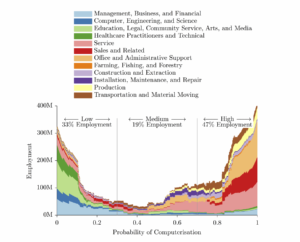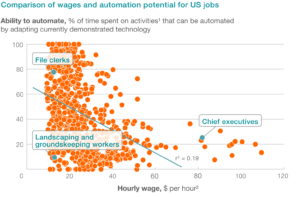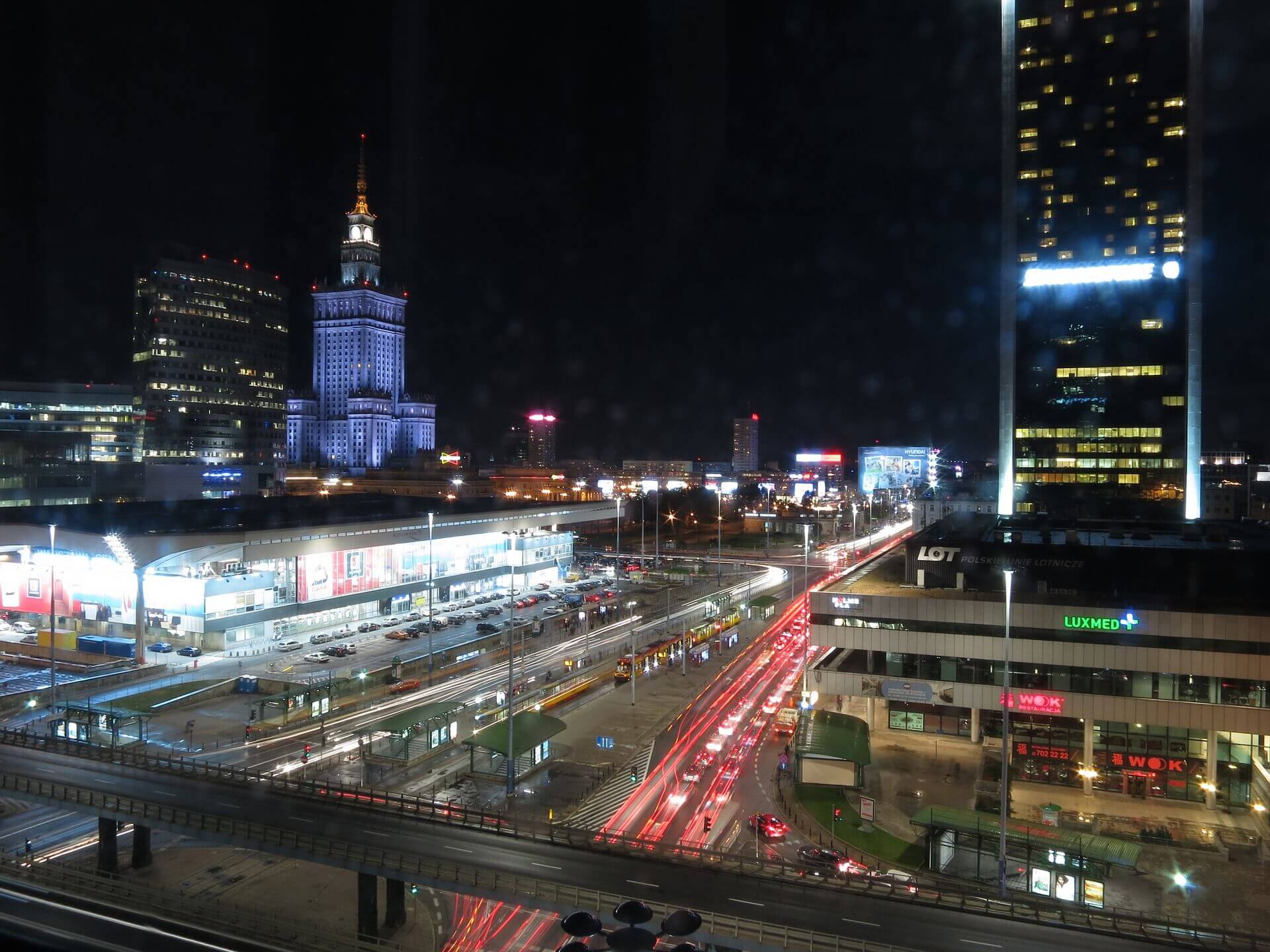The Great Divide
The United States is in the midst of a generation-long structural shift in labor, productivity, jobs, and pay. This shift began in the 1980s and is set to accelerate with the increasing adoption of advanced robotics and machine learning technologies. We are experiencing the most important changes in the nature of work since the Industrial Revolution, changes that affect nearly everything, from crime to electoral outcomes to national competitiveness.
To quote Andrew McAfee, the co-director of the MIT Initiative on the Digital Economy, “Digital technologies are doing for human brainpower what the steam engine and related technologies did for human muscle power during the Industrial Revolution.” Just as assumptions and fundamental behaviors that held true for agricultural societies were changed by the Industrial Revolution, assumptions and behaviors that characterized the industrial economy are being changed by the digital revolution.
The obvious outcome is that some types of jobs will go away and others will emerge. The less obvious but more important outcome is that this shift is fundamentally widening the gap between winners and losers, or those able to thrive in the digital economy and those being left behind. The workforce is bifurcating into winners and losers to a greater extent than ever before, and the dividing line is worker skill. Those with the right skills that are aligned to these emerging requirements are succeeding and accruing the benefits of the American economic engine. Those whose skills are misaligned are not participating in American economic growth, and are increasingly being left behind.
Our intent is not to place a value judgment on the changing shape of labor and the economy. Structural economic forces are not something that can be regulated or litigated away in a free society, and they are not effectively addressed via wishful thinking. These changes are occurring and have been occurring for some time. We simply seek to explain these changes and where we see the trends going because companies and public institutions are facing a serious, potentially existential issue that will require proactive solutions.
Source: Economic Policy Institute analysis of Current Population Survey Outgoing Rotation Group microdata. From “State of Working America Data Library,” “Wages by Education,” 2017.
Decoupling Productivity from Wages
The first fact to acknowledge when evaluating where we are today and how we got here is that the historical correlation between labor productivity and worker wages no longer exists. This was articulated as “the great decoupling” by economists Erik Brynjolfsson and Andrew McAfee in their 2015 book The Second Machine Age.
Throughout the last century labor productivity as measured by the amount of real GDP produced by one hour of labor continually increased as a result of technological and process-based innovation. Pay to workers as measured by real GDP per capita, median family income, and employment also increased in a corresponding factor. Worker productivity benefited the worker.
In the late 1970s or early 1980s these values began to diverge, or decouple. Labor productivity continued to increase, but the metrics around pay and employment grew much more slowly. In the 2000s and 2010s labor productivity continued to rise but pay and employment flatlined, and in some cases began to decrease. In the aggregate, the benefits of productivity accrued to the companies and shareholders as opposed to the workers. Work has become less important in the overall context of economic productivity.
Increasing Wage Disparity Based on Skill
The productivity and wage data discussed above deals with aggregate trends across the United States. When we look at the wage data on a more granular basis, a stark divergence between wages and skill emerges. According to an Economic Policy Institute analysis, between 1973 and 2016 inflation-adjusted wages for individuals with advanced degrees increased by 32%. During this same period wages for individuals with a high school degree decreased 6%, and wages for those without a high school degree decreased 17%.
Source:Economic Policy Institute, State of Working America Data Library, “Wages by Education,” 2017.
This demonstrates that while aggregate wages have been relatively flat, the distribution of outcomes according to skill as represented by educational attainment is enormous and growing. The emerging digital economy has proven to be great for those with the skills and training to participate, but disastrous for those without.
Labor Force Participation
At the most extreme end of the spectrum of haves and have nots, we find those who have been utterly left behind. The most direct manifestation of being left behind is dropping out of the labor force entirely. Unemployment statistics are important to consider but do not reflect people who are not actively looking for work. Aggregate labor force participation is another view that is important to consider, and this metric depicts a sharp downturn in labor force participation in the last 10 years.
Source: United States Bureau of Labor Statistics (BLS). Civilian labor force is a term used by the BLS to describe the subset of Americans who have jobs or are seeking a job, are at least 16 years old, are not serving in the military and are not institutionalized. In other words, all Americans who are eligible to work in the everyday U.S. economy.
Labor force participation rose as more women entered the workforce throughout the 20th century, then remained relatively constant from 1990-2008. From 2008-2016 the labor force participation rate dropped from 66% to just under 63%. The labor force participation rate in May 2016 was 62.6%, which equated to approximately 94.7 million Americans not working, near a 38 year low. When labor force participation is viewed by educational attainment or income the proportion of low-education, low-income workers who dropped out is more significant.
There are a number of different theories why fewer people are working. The 2008 recession was obviously a triggering event that led to a tragic number of job losses, but the lack of reentry into the workforce illustrates that this is not merely a recession issue that we should expect to rebound. Most of the hypotheses revolve around the idea that many workers who had their positions eliminated don’t have the right skills to fill the new jobs that are being created, and that people are opting out of a lower-income working existence because the cost of working outweighs the benefits.
Unfilled manufacturing jobs averaged 353,000 per month in 2016 as of September, which was almost three times the number in 2009 at the height of the recession. There were a record 5.9 million jobs available in July of 2016. These are generally viewed as positive indicators for the economy, but raise important questions about the skills gap between jobs and job-seekers.
Shrinking of the Middle Class
While dropping out of the workforce is clearly the starkest indication of the stress induced by the changing economy, it is important to note that these changes are also affecting the American middle class. The middle class is shrinking and has less relative wealth in a median sense than in the past century.
There are a number of different ways to calculate the middle class. Pew defines middle-class income as “at least two-thirds of the U.S. median household income, but no more than double the median.” According to Pew Research, the middle class shrank from 60.8% of Americans in 1971 to 49.9% in 2015, while the upper class grew from 14% to 21.1% and the lower class grew from 25.2% to 29%. Again we see evidence of growing bifurcation of outcomes between winners and losers.
Source: Pew Research. Pew defines middle class income as at least two-thirds of the U.S. median household income, but no more than double the median.
The purchasing power of the middle class has also decreased over time. Being a member of the middle class has historically meant that a family could own two cars and a house in a safe neighborhood. The United States Census bureau reports that the median household income in the country was $56,516 in 2015, which in most areas no longer supports the traditional middle class lifestyle.
In summary, we are in the midst of a secular shift that is accruing wealth to those with the skills to fully participate in the new economy to a greater degree than ever before. The segment of those being left behind, without the skills to participate, is also growing larger than ever before. Finally, the middle class is under pressure and shrinking relative to the upper and lower income segments of society.
This is a precarious labor foundation that we need to understand as we evaluate the impact of emerging advances in robotics, machine learning, and artificial intelligence (AI) technology.
AI and Robotics are Accelerants
It can be difficult to tell when new technologies represent a true phase shift bringing new economic realities versus merely incremental increases to current processes and trends. As the media business thrives on hype and controversy, which lead to eyeballs and revenue, we are often victim to overreaction and sweeping proclamations around disruptive technology.
Our analysis leads us to believe that the productization and broad adoption of interactive machines is very important and will affect every industry and public sector domain. Even if these technologies only end up representing the next incremental step on the decades-long transition to the digital economy, these trends towards the increasing social divide and bifurcation will continue. At the other end of the spectrum, however, is the potential displacement of a third of the workforce and destruction of the middle class.
A plethora of forecasts predict the types and net numbers of jobs at risk of being displaced by new technologies in this domain. They range from zero, based on the assumption that job creation will equal job destruction, to 50% and upwards, based on the assumption that every routine task and most non-creative tasks will be done by machines within the next 10 years.
This image depicts the probability of 702 different types of occupations being computerized within the next 1-2 decades (0 = none; 1 = certain) using a Guassian process statistical model. The authors of this study project that 47% are at risk of computerization. Source: “The future of employment: How susceptible are jobs to computerisation?” by Benedikt Frey and Michael A. Osborne. Published by the Oxford Martin Programme on Technology and Employment, Oxford University, September 17, 2013. Image: Michael Osborne and Benedikt Frey.
It is important to note that displacement is not limited to low-wage jobs. A McKinsey analysis of the Department of Labor O*NET database pointed out that there is only a low, statistically insignificant correlation between the average hourly wage of a job and the ability to automate that job.
This analysis was performed by McKinsey using data provided by the US Department of Labor, Employment and Training Administration. Using a linear model, they assess the coorelation between wages and automation potential to be significant (p-value<0.01) but with a high degree of variability (r-squared=0.19). Source: “Four Fundamentals of Workplace Automation” by Michael Chui, James Manyika, and Mehdi Miremadi. November 2015. O*NET 2014 database; McKinsey analysis. Image: McKinsey.
This somewhat surprising observation leads us to the conclusion that it is not only the lower class that is at risk. Of course the impact to lower-income Americans is critical, as those who have already been left behind to some degree are likely to find fewer opportunities and fall even further behind in a more automated economy.
The impact to middle-income Americans represents a potential cliff. If these technologies do in fact offset many traditionally middle-class jobs without creating a corresponding number of new jobs that these individuals have the skills to perform, we could experience a dramatic collapse of the middle class, which would have extremely negative social and political consequences.
An America of 2030 comprised of 40% lower-income, 20% middle-income, and 40% upper-income citizens is probably not the most likely scenario but is within the spectrum of possible outcomes.
Building the Future Workforce
This is not the first disruption to labor in this country, and the United States has demonstrated an impressive resilience in the face of prior disruption. There were 13,000 businesses in the wagon and carriage industry in 1890, according to Thomas Kinney in his book “The Carriage Trade: Making Horse-Drawn Vehicles in America.” And then the car came along, destroying that industry but creating others. Some of those 13,000 companies managed to transform their businesses, and now we have reached a point where just under 750,000 Americans work as automotive service technicians and mechanics. Another example is the bookkeeping profession, which faced an extremely difficult transition with the advent of the personal computer and spreadsheet software, yet accountants seem to have thrived.
We need to understand these trends and be proactive about adjusting our communities, businesses, and governments to these new realities. There is no one right answer. Business and public sector leaders must consider a number of different strategic alternatives that will result in positive outcomes. However, doing nothing or addressing these changes with wishful thinking is the wrong answer.
The solution does not lie in attempting to prevent change via reactionary and protectionist policies at the national level, although I will be astonished if Washington doesn’t try. The digital revolution is a force of nature that must be worked with, not against. This is about embracing change and preparing the next generation of workers for success.
If we have identified skills as the critical variable that determines if a worker is going to be a have or have not in this growing bifurcation of outcomes, our task is to determine how to equip the most Americans with the most relevant skills for the digital economy. This is not just a government issue; businesses, communities, and families all must be involved in and benefit from this transformation.
The wonderful part of the digital economy is that the barriers to success for skilled workers are lower than ever before. This is not a winner-take-all environment where workers compete for a fixed number of jobs in a limited industrial base. More skilled workers creates more opportunity and more economic productivity in a virtuous cycle. There is no downside to aligning the skills of workers with emerging economic requirements — it simply must be done.
Types of Skills
Several core skills are become increasingly important in the digital economy. Science, technology, engineering, and mathematics (STEM) clearly provide a basis to understand and collaborate with technology, as does computer science and programming. Equally important are the types of skills that machines cannot perform. Creativity and critical thinking enable success across disciplines and are increasingly important in the digital economy. Similarly, communications and adaptability will remain in the human domain for some time.
As the pace of technological change increases, workers need the skills and flexibility to adapt and adjust over the course of their careers. The average American worker will work for 12 companies over the course of their career, with an average duration of 4.2 years. Longevity at a company is not necessarily a good or bad thing, it is simply a reflection of the flexibility required in the digital economy that we should expect and train for going forward.
Education
The workforce of the industrial economy was hierarchical and oriented on process and efficiency. The American K-12 educational model adequately trained workers who fit the requirements of the hierarchical, process-driven, efficient workforce.
This traditional model of education needs to be reevaluated in context of the changing requirements of the digital economy. Government, education, and healthcare are the three sectors that have changed the least over the past 75 years. In our schools, the teacher teaches, the students listen, performance is evaluated in a standardized one-size-fits-all fashion, and everyone takes the summer off.
Some components of the education system work well, and teaching is the single-most important profession in this country. However, we may want to rethink the education process in context of the end product of skilled citizens that it is designed to create.
Hiring and Training
Companies also need to evaluate their hiring and training processes in context of emerging worker requirements. Modern businesses survive and thrive because of human capital. Some industries have done better than others in recruiting and training talent, but this also requires a different paradigm in light of the digital economy.
From the hiring perspective, if we acknowledge that companies are rapidly iterating with new technology and business processes, the imperative is to hire workers who have the flexibility and creativity to drive these iterations. We need people who have the necessary baseline understanding of our industry but who also, and more importantly, have the skills to grow, change, communicate, and create value.
The hiring and interview process is often inefficient at finding the type of people businesses actually need. Candidates submit resumes, and junior human resources professionals (or software) screen them for the required job titles and tenure. Candidates who have not been in static roles are often disqualified, when in fact what companies ultimately want and need is agility and flexibility. Then the interview process begins, and managers naturally seek to derisk hiring by looking for individuals with demonstrated prior success. Unfortunately, this ignores the fact that success in yesterday’s environment is not the same as success in tomorrow’s environment.
This is a drastic oversimplification, but the hiring process at many companies has been the same for decades. Organizations where this is the case may be well served by reevaluating this process in context of the skills they seek to bring in.
Training is another area many companies underinvest in or ignore, and it affects both business performance and retention. If businesses want to hire creative, agile, critical-thinking communicators as opposed to individuals who have done the same task over and over for 20 years, they need to build a concurrent framework to train their workers and continue training them as the business and requirements evolve. The precise workers who will excel at leading growth and change within organizations will leave when they are no longer able to grow and change.
Inclusion and National Competitiveness
Aligning the skills of as many people as possible to the labor requirements of the digital economy benefits everyone. It will result in happier, more fulfilled, and better compensated workers, lower crime, higher productive economic output, and a larger tax base.
Conversely, degrading into a bifurcated society of haves and have nots along the skill divide benefits no one. This outcome will result in less productivity, more strife, fewer resources, and a disenfranchised majority that will change the fabric of this country.
National competitiveness must be addressed at the business, community, state, and national level. It transcends race, class, political ideology, age, gender, and region. Of course, these are important considerations as some groups have more ground to make up than others. However, human talent is our most important asset and we all benefit from getting this right.
Join the Catalyst Monitor
Join our community, where we push out regular insights to help maintain situational awareness on technological and socioeconomic trends.





